Submitted:
29 January 2024
Posted:
31 January 2024
Read the latest preprint version here
Abstract
Keywords:
1. Introduction
1.1. Observer camouflage metrics
1.2. Computational camouflage metrics
1.3. YOLO camouflage metric
2. Experiment 1: YOLO detection performance for camouflaged persons
2.1. Methods
2.2. Results
3. Experiment 2: YOLO vs human camouflaged person detection on photosimulations
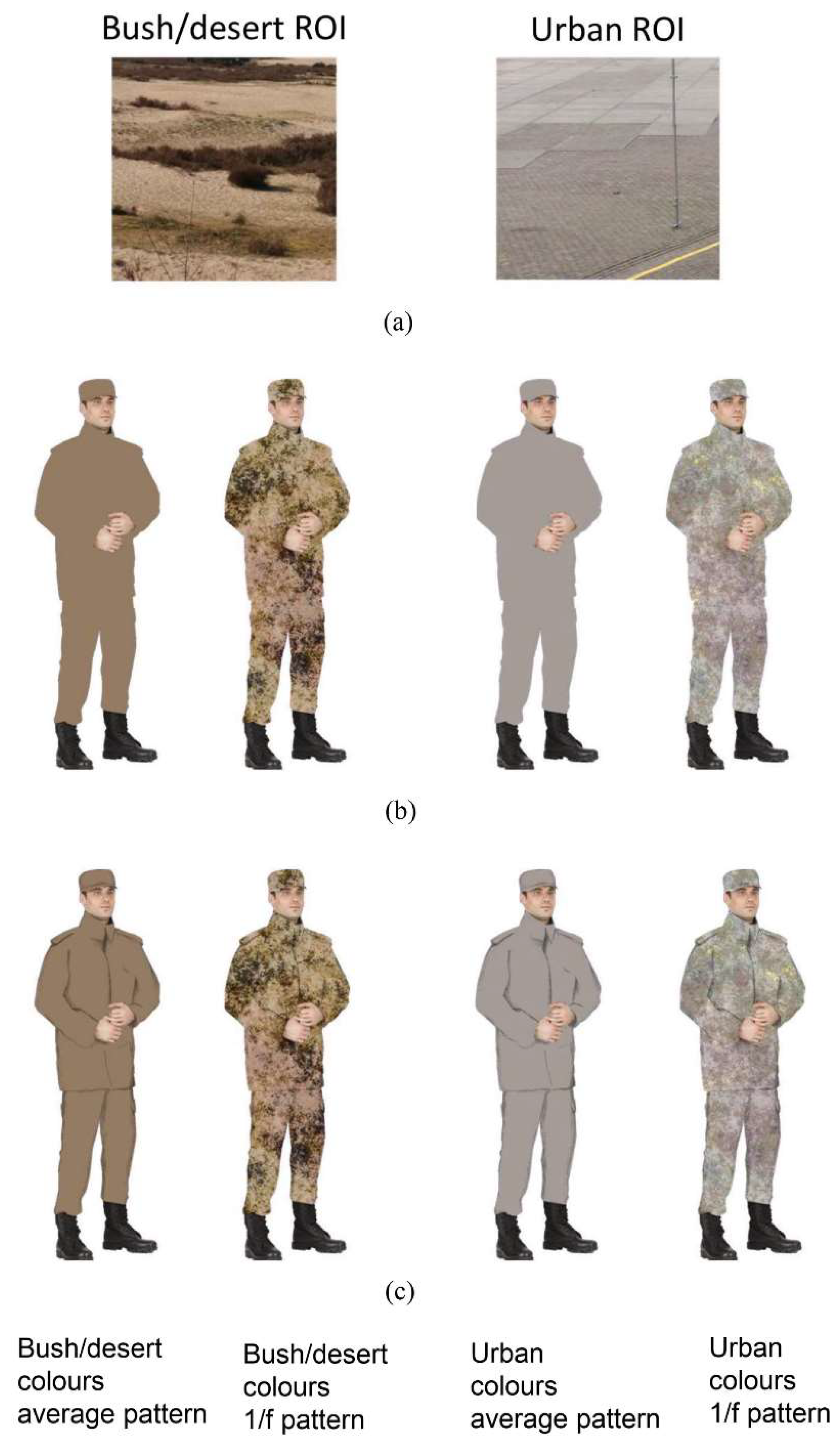
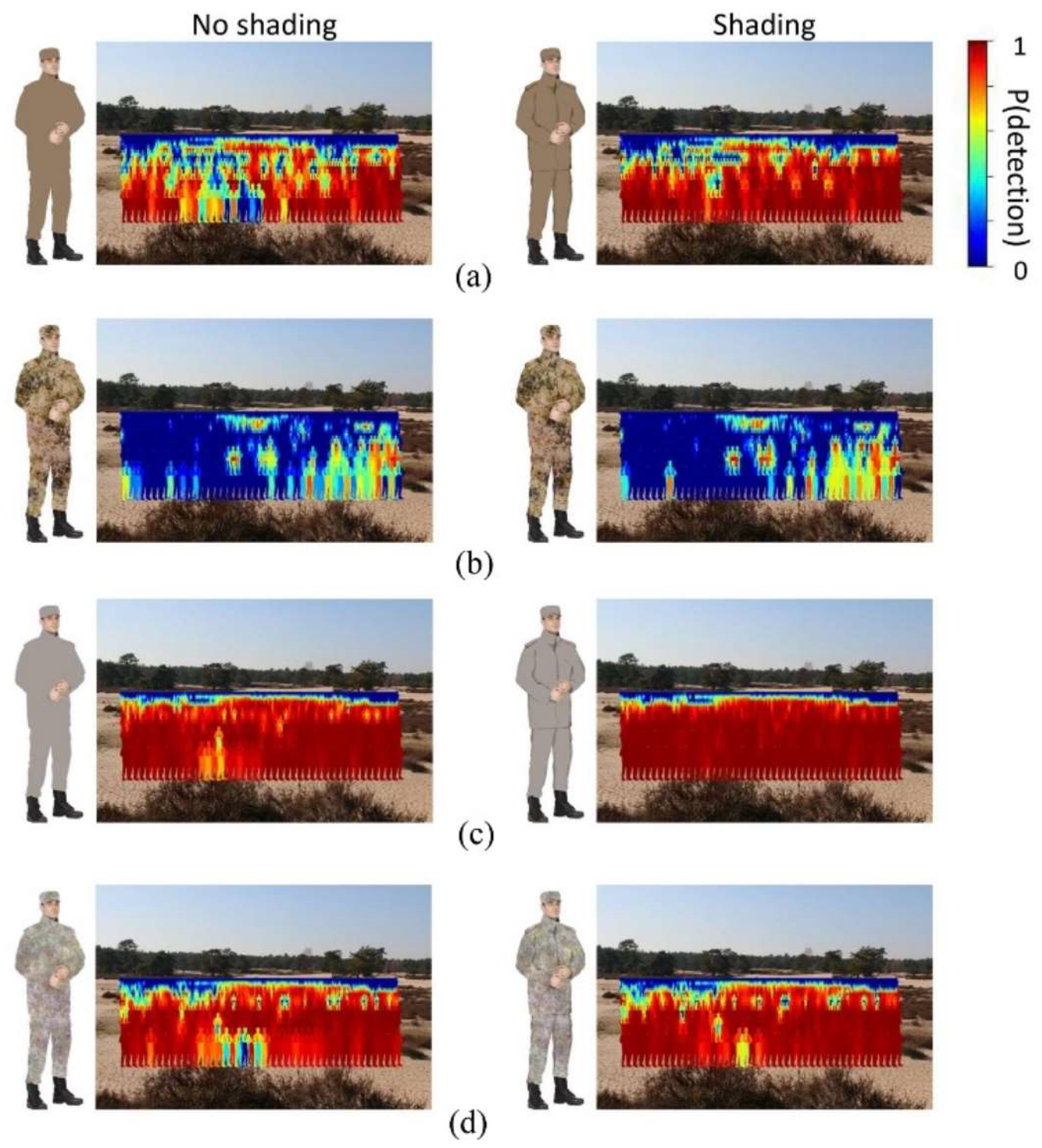
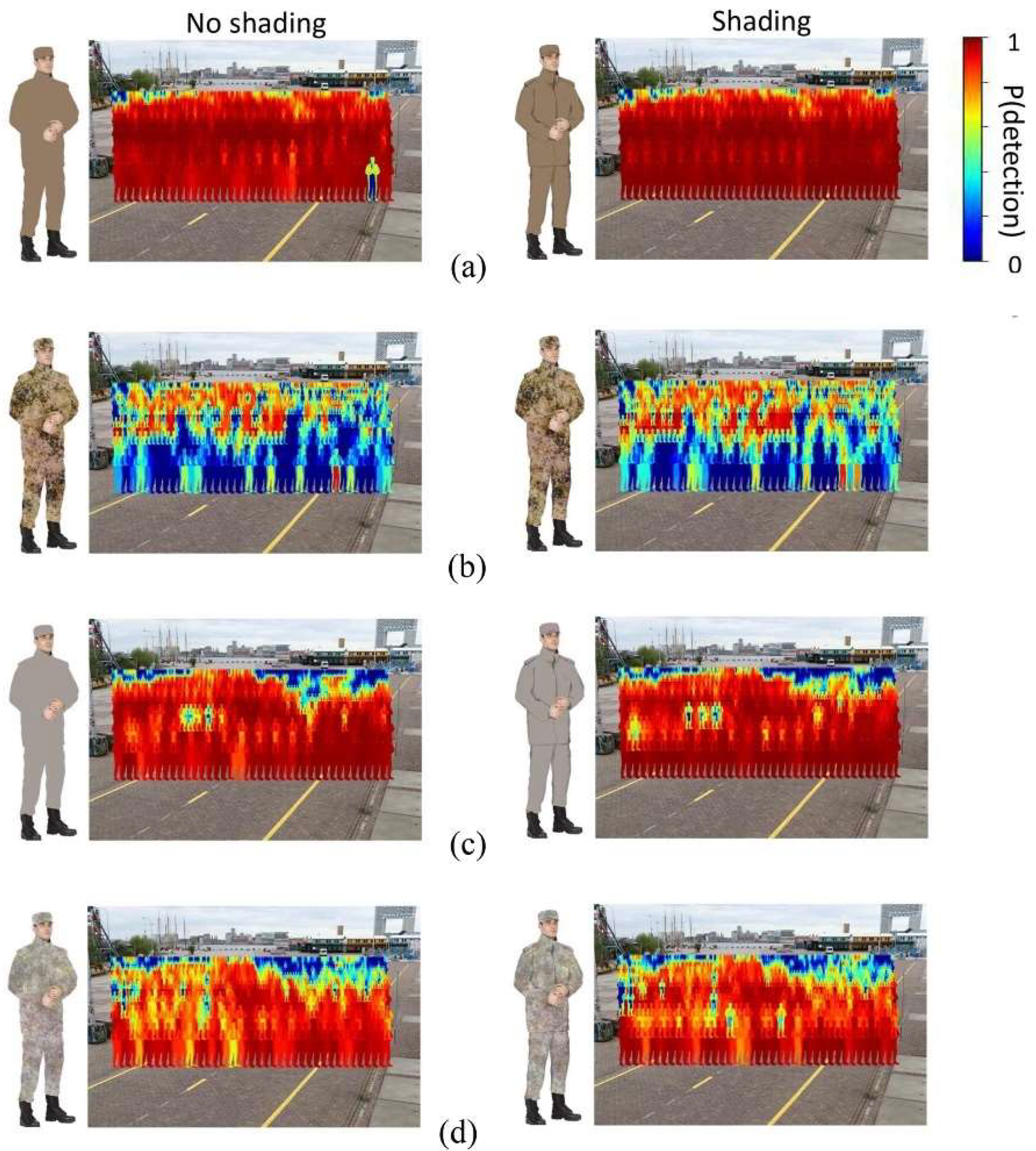
3.1. Methods Experiment 2a
3.2. Methods Experiment 2b
3.2.1. Participants
3.2.2. Stimuli and apparatus
3.2.3. Design and procedure
3.3. Results
4. Experiment 3: YOLO vs human camouflaged person detection on naturalistic images
4.1. Methods Experiment 3a
4.2. Methods Experiment 3b
4.3. Results
5. Discussion
5.1. Limitations
Supplementary Materials
Author Contributions
Funding
Institutional Review Board Statement
Informed Consent Statement
Conflicts of Interest
References
- Toet, A. Computational versus psychophysical image saliency: a comparative evaluation study. IEEE Transactions on Pattern Analysis and Machine Intelligence 2011, 33, 2131–2146. [Google Scholar] [CrossRef]
- Toet, A.; Hogervorst, M. Review of camouflage assessment techniques. In Proceedings of the Target and Background Signatures VI, 20 September 2020; pp. 1–29. [Google Scholar] [CrossRef]
- Ramsey, S.; Mayo, T.; Howells, C.; Shabaev, A.; Lambrakos, S.G. Modeling apparent camouflage patterns for visual evaluation. In Proceedings of the Algorithms and Technologies for Multispectral, Hyperspectral, and Ultraspectral Imagery XXIV; 2018; p. 1064428. [Google Scholar] [CrossRef]
- Ramsey, S.; Mayo, T.; Shabaev, A.; Lambrakos, S. Modeling apparent color for visual evaluation of camouflage fabrics. In Proceedings of the Optics and Photonics for Information Processing XI; 2017; p. 103950. [Google Scholar] [CrossRef]
- Cass, J.; Van der Burg, E.; Alais, D. Finding flicker: Critical differences in temporal frequency capture attention. Front. Psychol. 2011, 2, 1–7. [Google Scholar] [CrossRef] [PubMed]
- Van der Burg, E.; Cass, J.; Olivers, C.N.L.; Theeuwes, J.; Alais, D. Efficient visual search from synchronized auditory signals requires transient audiovisual events. PLOS ONE 2010, 5, e10664. [Google Scholar] [CrossRef] [PubMed]
- Van der Burg, E.; Cass, J.; Theeuwes, J. Changes (but not differences) in motion direction fail to capture attention. Vision Research 2019, 165, 54–63. [Google Scholar] [CrossRef]
- Toet, A.; Bijl, P. Visual conspicuity. In Encyclopedia of optical engineering; Driggers, R.G., Ed.; Marcel Dekker Inc., 2003; pp. 2929–2935. [Google Scholar]
- Toet, A.; Bijl, P.; Kooi, F.L.; Valeton, J.M. Quantifying target distinctness through visual conspicuity. In Proceedings of the Targets and Backgrounds: Characterization and Representation IV, Bellingham, WA; 1998; pp. 152–163. [Google Scholar] [CrossRef]
- Toet, A.; Kooi, F.L.; Bijl, P.; Valeton, J.M. Visual conspicuity determines human target acquisition performance. Optical Engineering 1998, 37, 1969–1975. [Google Scholar] [CrossRef]
- Kooi, F.L.; Toet, A. Conspicuity: an efficient alternative for search time; Gale, A.G., Brown, I.D., Haslegrave, C.M., Taylor, S.P., Eds.; Elsevier Science Ltd.: Oxford, UK, 1999; Volume VII, pp. 451–462. [Google Scholar]
- van der Burg, E.; Ju, J.; Hogervorst, M.A.; Lee, B.; Culpepper, J.; Toet, A. The relation between visual search and visual conspicuity for moving targets. In Proceedings of the Target and Background Signatures VII, Online, 12 September 2021; pp. 92–101. [Google Scholar] [CrossRef]
- Toet, A.; de Vries, S.C.; Bijl, P.; Kooi, F.L. Validation of military target representation in a simulator through conspicuity; TNO Human Factors: Soesterberg, The Netherlands, 1996 1996. [Google Scholar]
- Toet, A.; Hogervorst, M.A. Urban camouflage assessment through visual search and computational saliency. Optical Engineering 2013, 52, 1–8. [Google Scholar] [CrossRef]
- Beintema, J.A.; Toet, A. Conspicuity of moving soldiers. In Proceedings of the Infrared Imaging Systems: Design, Analysis, Modeling, and Testing XXII, Orlando, FL, USA; 2011; pp. 1–12. [Google Scholar] [CrossRef]
- Toet, A. Visual conspicuity of targets in synthetic IR imagery. In Camouflage, Concealment and Deception Evaluation Techniques; Toet, A., Ed.; North Atlantic Treaty Organization: Neuilly-sur-Seine Cedex, France, 2001; Volume RTO-TM-017 AC/323(SCI-012)TP/32, pp. 137–152. [Google Scholar]
- Toet, A.; Kooi, F.L.; Kuijper, F.; Smeenk, R.J.M. Objective assessment of simulated daytime and NVG image fidelity. In Proceedings of the Enhanced and Synthetic Vision 2005; 2005; pp. 1–10. [Google Scholar] [CrossRef]
- Toet, A. Structural similarity determines search time and detection probability. Infrared Physics & Technology 2010, 53, 464–468. [Google Scholar] [CrossRef]
- Wang, Y.; Li, L.; Yang, X.; Wang, X.; Liu, H. A camouflaged object detection model based on deep learning. In Proceedings of the 2020 IEEE International Conference on Artificial Intelligence and Information Systems (ICAIIS), 20-22 March 2020; pp. 150–153. [Google Scholar] [CrossRef]
- Redmon, J.; Farhadi, A. Yolov3: An incremental improvement. arXiv:1804.02767 2018.
- Van der Burg, E.; Hogervorst, M.A.; Toet, A. Measuring the dynamics of camouflage in natural scenes using convolutional neural networks. In Proceedings of the Target and Background Signatures VIII, Berlin, Germany; 2022. [Google Scholar] [CrossRef]
- Van der Burg, E.; Hogervorst, M.A.; Toet, A. Adaptive camouflage for moving objects. Journal of Perceptual Imaging 2021, 4, 20502-20501-20502-20515. [Google Scholar] [CrossRef]
- Wang, C.-Y.; Bochkovskiy, A.; Liao, H.-Y.M. Scaled-yolov4: Scaling cross stage partial network. In Proceedings of the IEEE/cvf conference on computer vision and pattern recognition; 2021; pp. 13029–13038. [Google Scholar]
- Duncan, J.; Humphreys, G.W. Visual search and stimulus similarity. Psychological Review 1989, 96, 433–458. [Google Scholar] [CrossRef]
- Selj, G.K.; Heinrich, D.H. Disruptive coloration in woodland camouflage: evaluation of camouflage effectiveness due to minor disruptive patches. In Proceedings of the Target and Background Signatures II; 2016; pp. 83–97. [Google Scholar] [CrossRef]
- Zhang, Y.; Zhang, W.; Yu, J.; He, L.; Chen, J.; He, Y. Complete and accurate holly fruits counting using YOLOX object detection. Computers and Electronics in Agriculture 2022, 198, 107062. [Google Scholar] [CrossRef]
- Sun, H.; Wang, B.; Xue, J. YOLO-P: An efficient method for pear fast detection in complex orchard picking environment. Frontiers in plant science 2023, 13, 1089454. [Google Scholar] [CrossRef] [PubMed]
- Billock, V.A. Neural acclimation to 1/f spatial frequency spectra in natural images transduced by the human visual system. Physica D: Nonlinear Phenomena 2000, 137, 379–391. [Google Scholar] [CrossRef]
- Chapeau-Blondeau, F.; Chauveau, J.; Rousseau, D.; Richard, P. Fractal structure in the color distribution of natural images. Chaos, Solitons & Fractals 2009, 42, 472–482. [Google Scholar] [CrossRef]
- Chauveau, J.; Rousseau, D.; Chapeau-Blondeau, F. Fractal capacity dimension of three-dimensional histogram from color images. Multidimensional Systems and Signal Processing 2010, 21, 197–211. [Google Scholar] [CrossRef]
- Chauveau, J.; Rousseau, D.; Richard, P.; Chapeau-Blondeau, F. Multifractal analysis of three-dimensional histogram from color images. Chaos, Solitons & Fractals 2010, 43, 57–67. [Google Scholar] [CrossRef]
- Field, D.J. Relations between the statistics of natural images and the response properties of cortical cells. Journal of the Optical Society of America A 1987, 4, 2379–2394. [Google Scholar] [CrossRef]
- Torralba, A.; Oliva, A. Statistics of natural images categories. Network: Computation in Neural Systems 2003, 14, 391–412. [Google Scholar] [CrossRef]
- Pitié, F.; Kokaram, A.C.; Dahyot, R. Automated colour grading using colour distribution transfer. Computer Vision and Image Understanding 2007, 107, 123–137. [Google Scholar] [CrossRef]
- World Medical Association. World Medical Association declaration of Helsinki: Ethical principles for medical research involving human subjects. J. Am. Med. Assoc. 2013, 310, 2191–2194. [Google Scholar] [CrossRef]
- Peirce, J.W. PsychoPy -- Psychophysics software in Python. Journal of Neuroscience Methods 2007, 162, 8–13. [Google Scholar] [CrossRef]
- Peirce, J.W. Generating stimuli for neuroscience using PsychoPy. Frontiers in Neuroinformatics 2009, 2, 10–11. [Google Scholar] [CrossRef]
- Toet, A.; Bijl, P. Visual search. In Proceedings of the Encyclopedia of optical engineering; 2003; pp. 2949–2954. [Google Scholar] [CrossRef]
- Van der Burg, E.; Olivers, C.N.; Bronkhorst, A.W.; Theeuwes, J. Pip and pop: nonspatial auditory signals improve spatial visual search. Journal of Experimental Psychology: Human Perception and Performance 2008, 34, 1053–1065. [Google Scholar] [CrossRef]
- Van der Burg, E.; Olivers, C.N.; Bronkhorst, A.W.; Theeuwes, J. Poke and pop: tactile-visual synchrony increases visual saliency. Neuroscience Letters 2009, 450, 60–64. [Google Scholar] [CrossRef]
- Terven, J.; Cordova-Esparza, D. A comprehensive review of YOLO: From YOLOv1 to YOLOv8 and beyond. arXiv:2304.00501 2023. [CrossRef]
- Diwan, T.; Anirudh, G.; Tembhurne, J.V. Object detection using YOLO: challenges, architectural successors, datasets and applications. Multimedia Tools and Applications 2023, 82, 9243–9275. [Google Scholar] [CrossRef]
- Jiang, P.; Ergu, D.; Liu, F.; Cai, Y.; Ma, B. A Review of Yolo Algorithm Developments. Procedia Computer Science 2022, 199, 1066–1073. [Google Scholar] [CrossRef]
- Dahirou, Z.; Zheng, M. Motion detection and object detection: Yolo (You Only Look Once). In Proceedings of the 2021 7th Annual International Conference on Network and Information Systems for Computers (ICNISC), Guiyang, China, 23-25 July 2021; pp. 250–257. [Google Scholar] [CrossRef]
- Abrams, R.A.; Christ, S.E. Motion onset captures attention. Psychol. Sci. 2003, 14, 427–432. [Google Scholar] [CrossRef]
- Abrams, R.A.; Christ, S.E. The onset of receding motion captures attention: Comment on Franconeri and Simons (2003). Perception & Psychophysics 2005, 67, 219–223. [Google Scholar] [CrossRef]
- Howard, C.J.; Holcombe, A.O. Unexpected changes in direction of motion attract attention. Atten Percept Psychophys 2010, 72, 2087–2095. [Google Scholar] [CrossRef] [PubMed]
- Hall, J.R.; Cuthill, I.C.; Baddeley, R.B.; Shohet, A.J.; Scott-Samuel, N.E. Camouflage, detection and identification of moving targets. Proceedings of the Royal Society B: Biological Sciences 2013, 280, 20130064. [Google Scholar] [CrossRef] [PubMed]
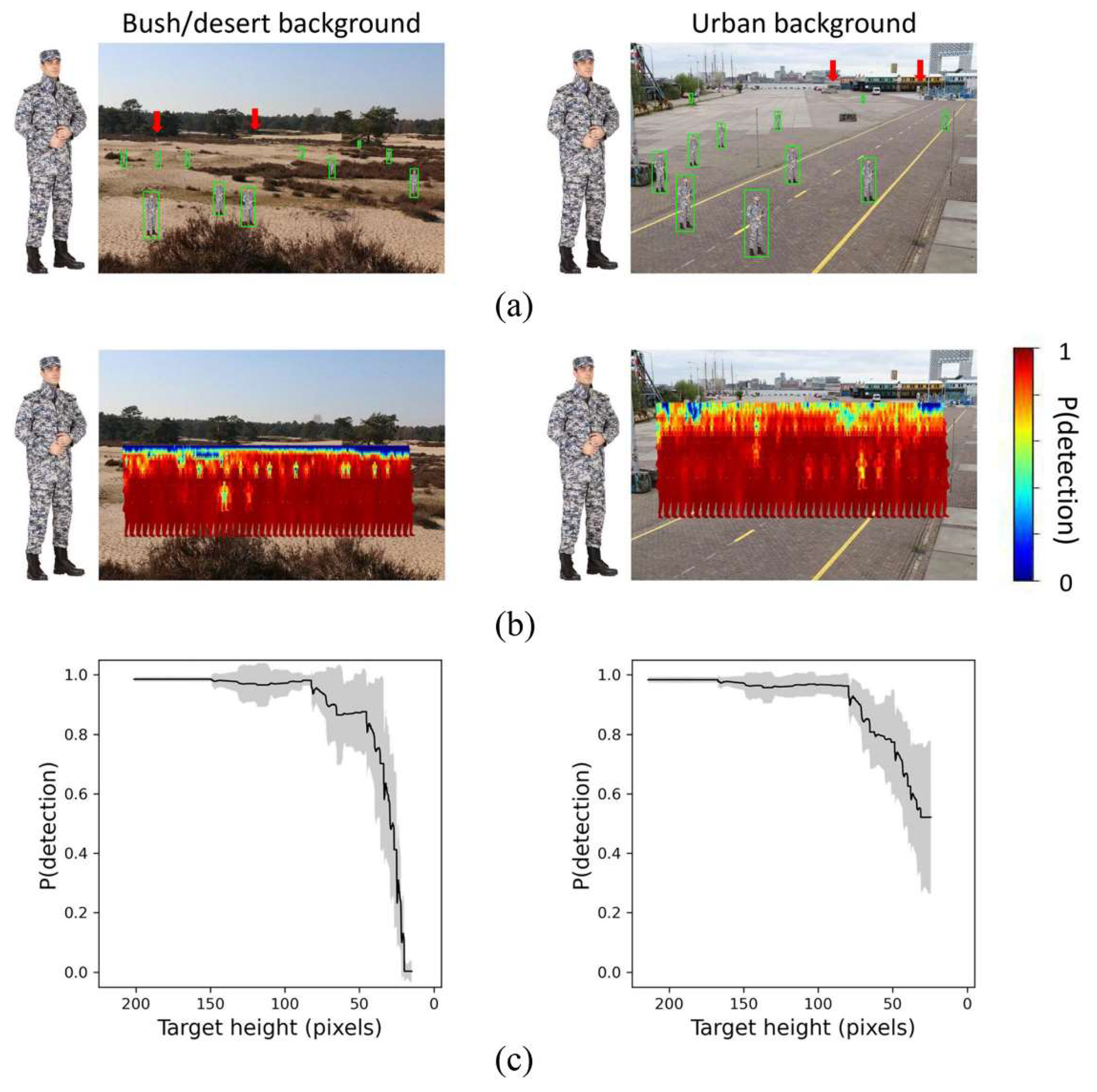
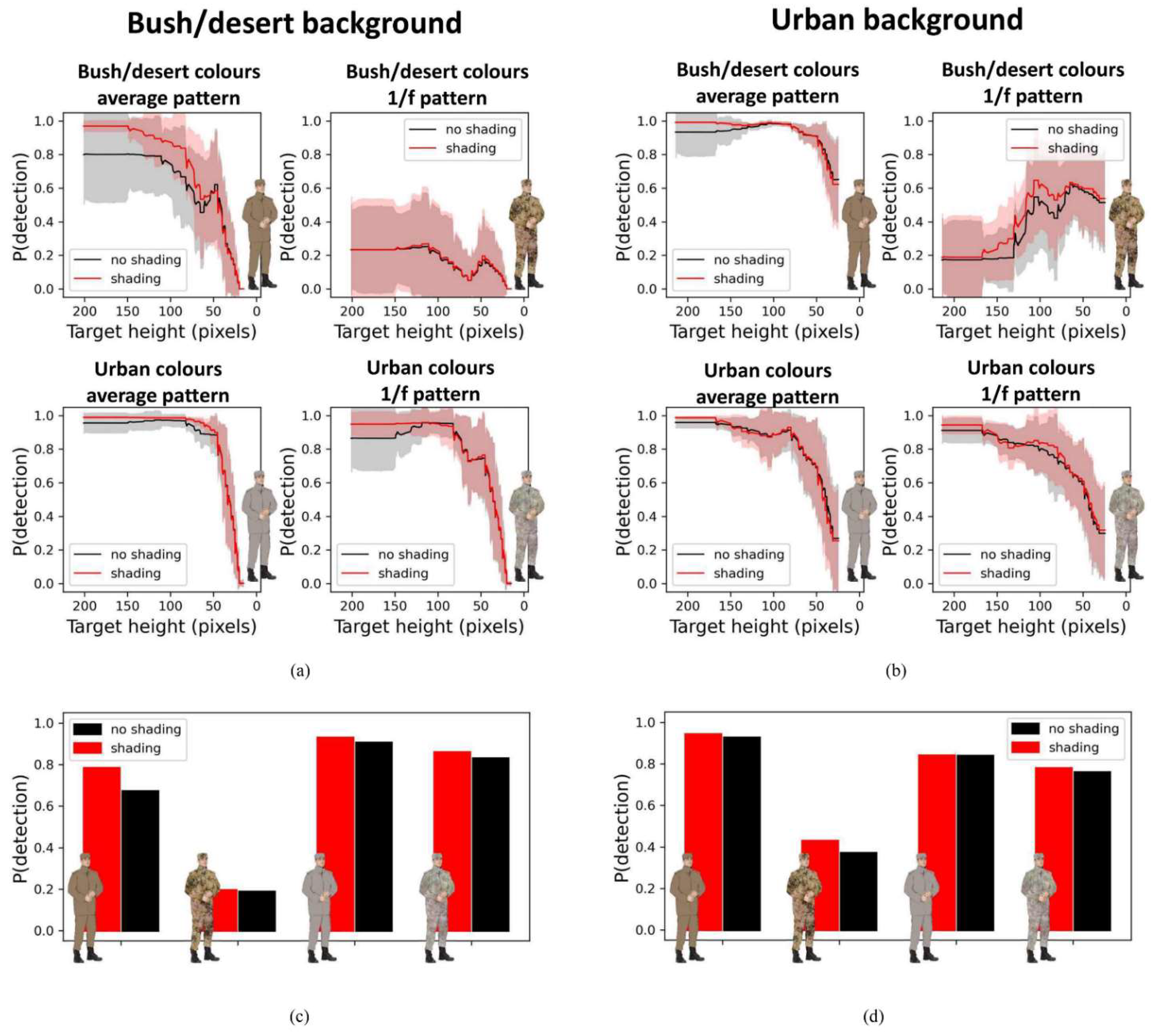
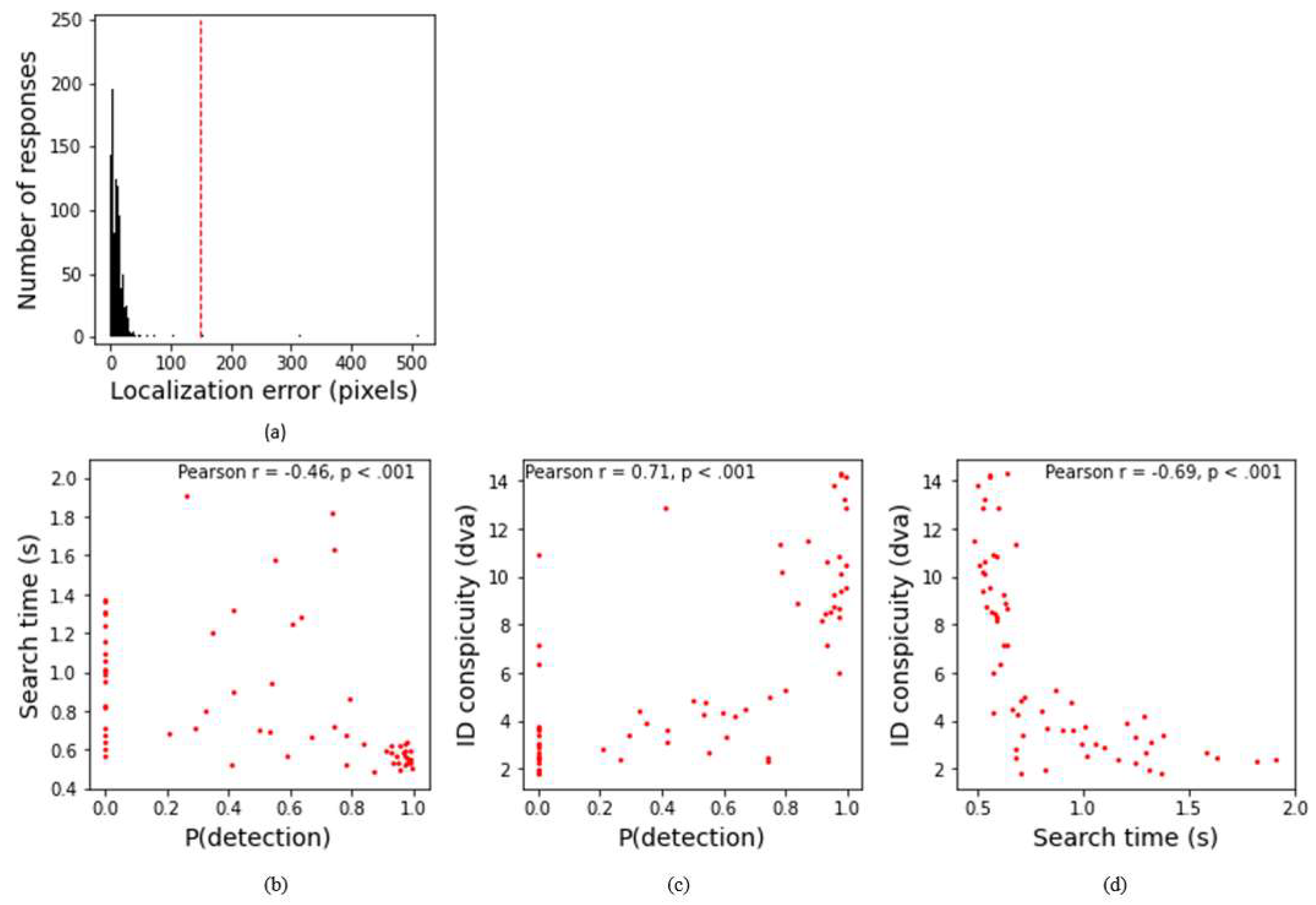

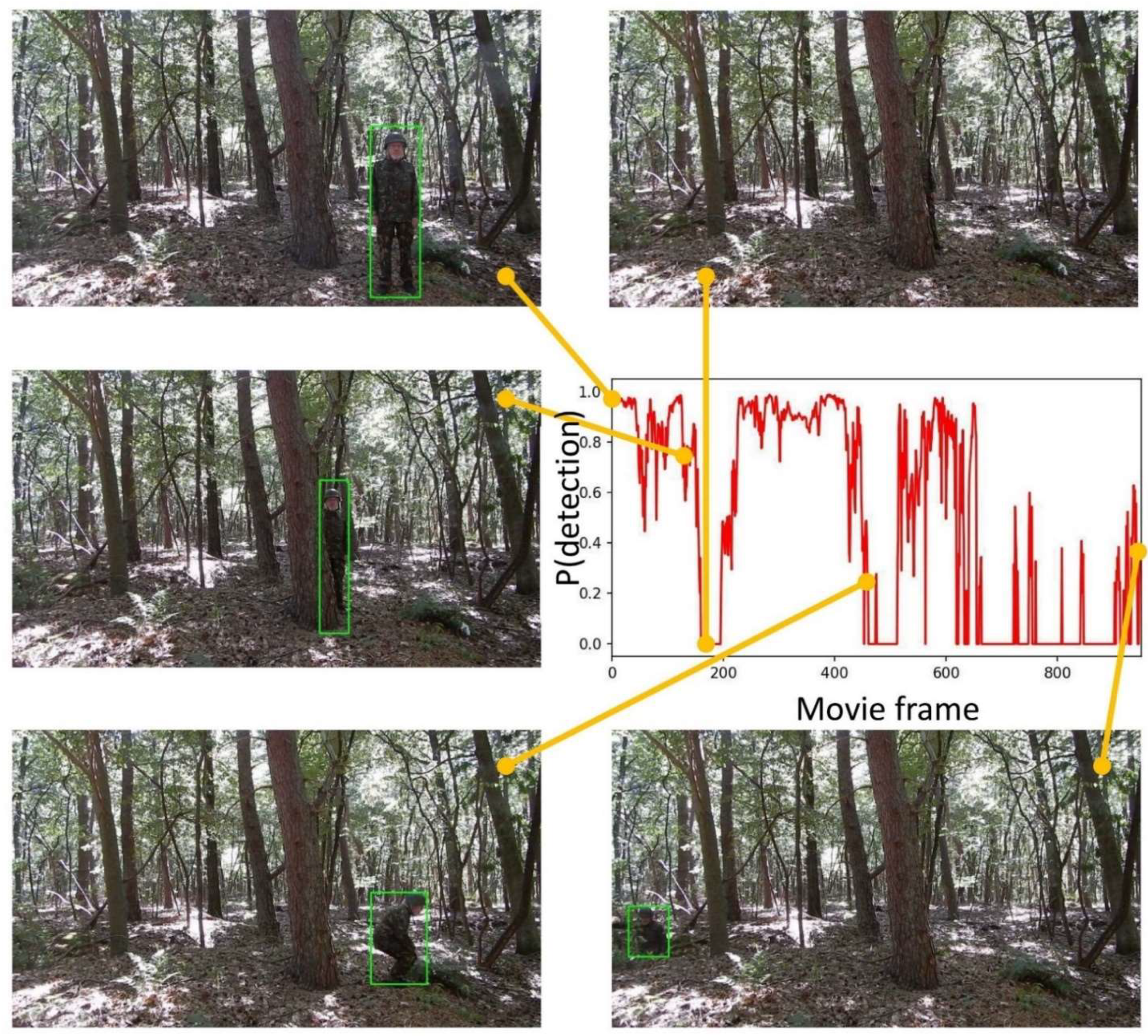
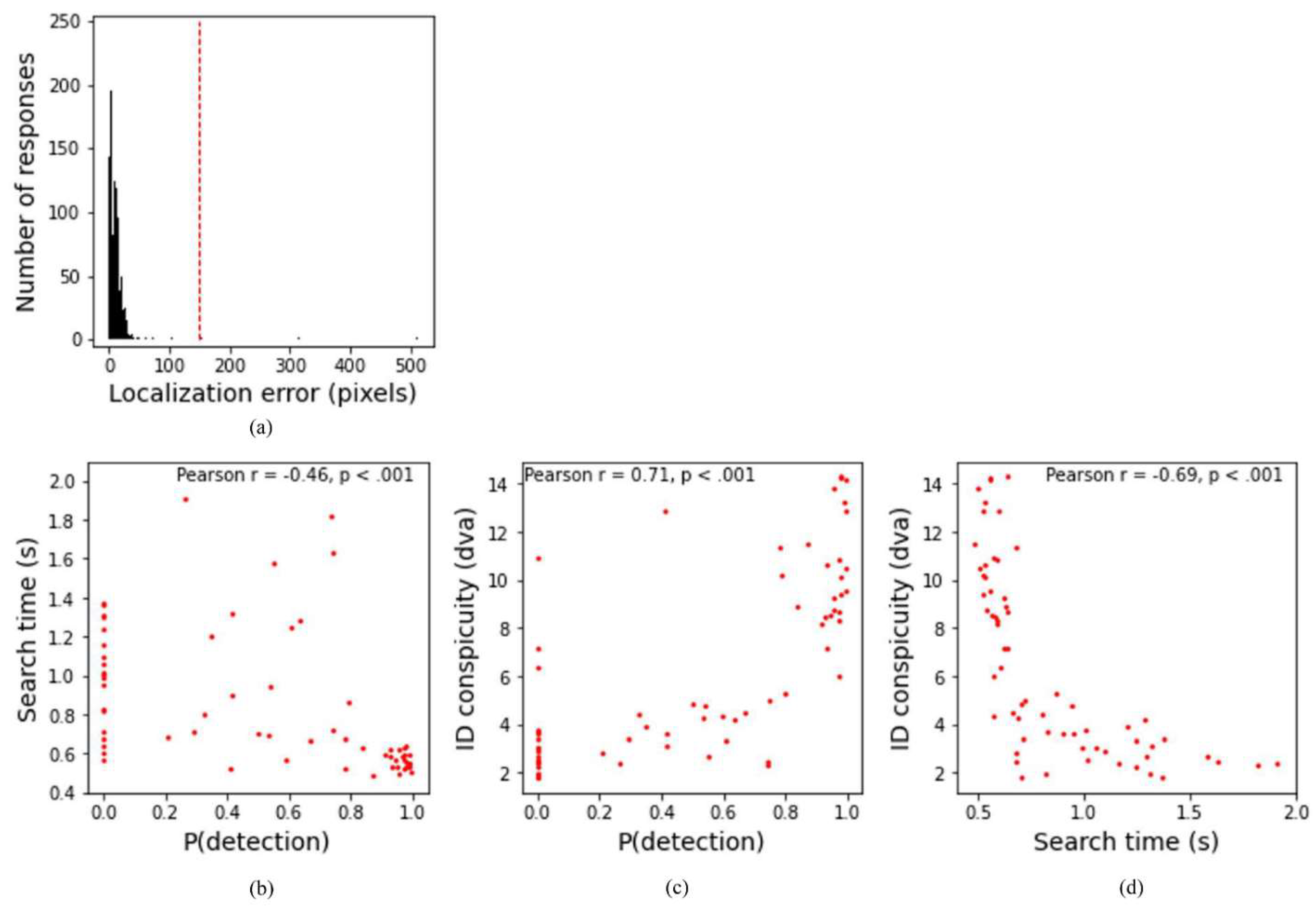
| P(detection) × Search | P(detection) × Conspicuity | Search × Conspicuity | ||||
|---|---|---|---|---|---|---|
| Subject | Pearson r | p | Pearson r | p | Pearson r | p |
| 1 | -0.36 | < 0.01 | 0.71 | < .001 | -0.6 | < .001 |
| 2 | -0.42 | < .001 | 0.67 | < .001 | -0.57 | < .001 |
| 3 | -0.46 | < .001 | 0.7 | < .001 | -0.7 | < .001 |
| 4 | -0.45 | < .001 | 0.68 | < .001 | -0.59 | < .001 |
| 5 | -0.37 | < .01 | 0.6 | < .001 | -0.42 | < .001 |
| 6 | -0.48 | < .001 | 0.69 | < .001 | -0.73 | < .001 |
| mean | -0.46 | < .001 | 0.71 | < .001 | -0.69 | < .001 |
| Search × P(detection) | Conspicuity × P(detection) | Conspicuity × Search | ||||
|---|---|---|---|---|---|---|
| Subject | Pearson r | p | Pearson r | p | Pearson r | p |
| 1 | -0.27 | 0.351 | 0.73 | < 0.01 | -0.17 | 0.572 |
| 2 | -0.17 | 0.570 | 0.61 | < 0.05 | -0.49 | 0.075 |
| 3 | -0.45 | 0.104 | 0.65 | <0 .05 | -0.02 | 0.941 |
| 4 | -0.33 | 0.254 | 0.69 | < 0.01 | -0.09 | 0.756 |
| 5 | -0.36 | 0.211 | 0.34 | 0.237 | 0.11 | 0.714 |
| 6 | -0.22 | 0.443 | 0.63 | < 0.05 | -0.13 | 0.647 |
| mean | -0.52 | 0.057 | 0.69 | < 0.01 | -0.2 | 0.502 |
Disclaimer/Publisher’s Note: The statements, opinions and data contained in all publications are solely those of the individual author(s) and contributor(s) and not of MDPI and/or the editor(s). MDPI and/or the editor(s) disclaim responsibility for any injury to people or property resulting from any ideas, methods, instructions or products referred to in the content. |
© 2024 by the authors. Licensee MDPI, Basel, Switzerland. This article is an open access article distributed under the terms and conditions of the Creative Commons Attribution (CC BY) license (http://creativecommons.org/licenses/by/4.0/).





